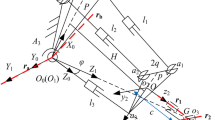Abstract
For a 6R milling robot, it is necessary to convert the postprocessing cutter locations (CL) into the robot’s revolute joint variables. This paper introduces an algorithm for calculating the forward and inverse kinematics of a 6R robot according to the CL data generated by conventional CAD/CAM systems. A redundant mechanism is analyzed to avoid the singular configurations and joint limits. The Denavit–Hartenberg (D–H) convention is referred to for developing the forward kinematics, and a closed-form solution of the inverse kinematics is presented by means of kinematic decoupling. A fundamental approach with modifying factor for avoiding singularity are developed with regard to three-axis and five-axis CL data. A gap bridging strategy is applied to reduce the jerk motion caused by tool retraction and cut paths connection. Finally, the result is conducted to simulation and machining test to verify the algorithms.










Similar content being viewed by others
References
Abele E (2007) Spanende Bearbeitung mit Industrierobotern, Forschungsprojekt ADVOCUT: Entwicklungen und Industrie-transfer. Institut für Produktionsmanagement, Technische Universität Darmstadt
Sorby K (2007) Inverse kinematics of five-axis machines near singular configurations. Int J Mach Tool Manufact 47:299–306
Affouard A, Duc E, Lartigue C, Langeron JM, Bourdet P (2004) Avoiding 5-axis singularities using tool path deformation. Int J Mach Tool Manufact 44:415–425
Munlin M, Makhanov SS, Bohez ELJ (2004) Optimization of rotations of a five-axis milling machine near stationary points. Comput Aided Des 36:1117–1128
Chang PH (1987) A closed-form solution for inverse kinematics of robot manipulators with redundancy. IEEE J Robot Autom 5:393–403
Siciliano B (1990) Kinematic control of redundant robot manipulators: a Tutorial. J Intell Robotic Syst 3:201–212
Yoshihiko N (1991) Advanced robotics redundancy and optimization. Addison-Wesley Publishing Company, Boston
Phillip JM (1990) Introduction to robotics. Addison-Wesley Publishing Company, Boston
Mittal RK, Nagrath IJ (2003) Robotics and control. Tata McGraw-Hill, New Delhi
Paul RP (1981) Robot manipulators. MIT Press, Cambridge
Spong MW, Vidyasagar M (1989) Robot dynamics and control. Wiley, New York
Siciliano B, Khatib O (2008) Springer Handbook of Robotics. Springer, Berlin
Tchon K, Muszynski R (1997) Singularities of nonredundant robot kinematics. Int J Robot Res 16: 60–76
Nof SY (1985) Handbook of industrial robotics. Wiley, New York
Bazaraa MS, Sherali HD, Shetty CM (2006) Nonlinear programming theory and algorithms. A John Wiley and Sons, Inc. Publication, New Jersey
Maaß J, Kolbus M, Bier C, Wobbe F, Schumacher W, Raatz A, Hesselbach J (2008) In: 3rd International Colloquium of the Collaborative Research Center SFB 562:285–296
Author information
Authors and Affiliations
Corresponding author
Rights and permissions
About this article
Cite this article
Xiao, W., Strauß, H., Loohß, T. et al. Closed-form inverse kinematics of 6R milling robot with singularity avoidance. Prod. Eng. Res. Devel. 5, 103–110 (2011). https://doi.org/10.1007/s11740-010-0283-9
Received:
Accepted:
Published:
Issue Date:
DOI: https://doi.org/10.1007/s11740-010-0283-9




